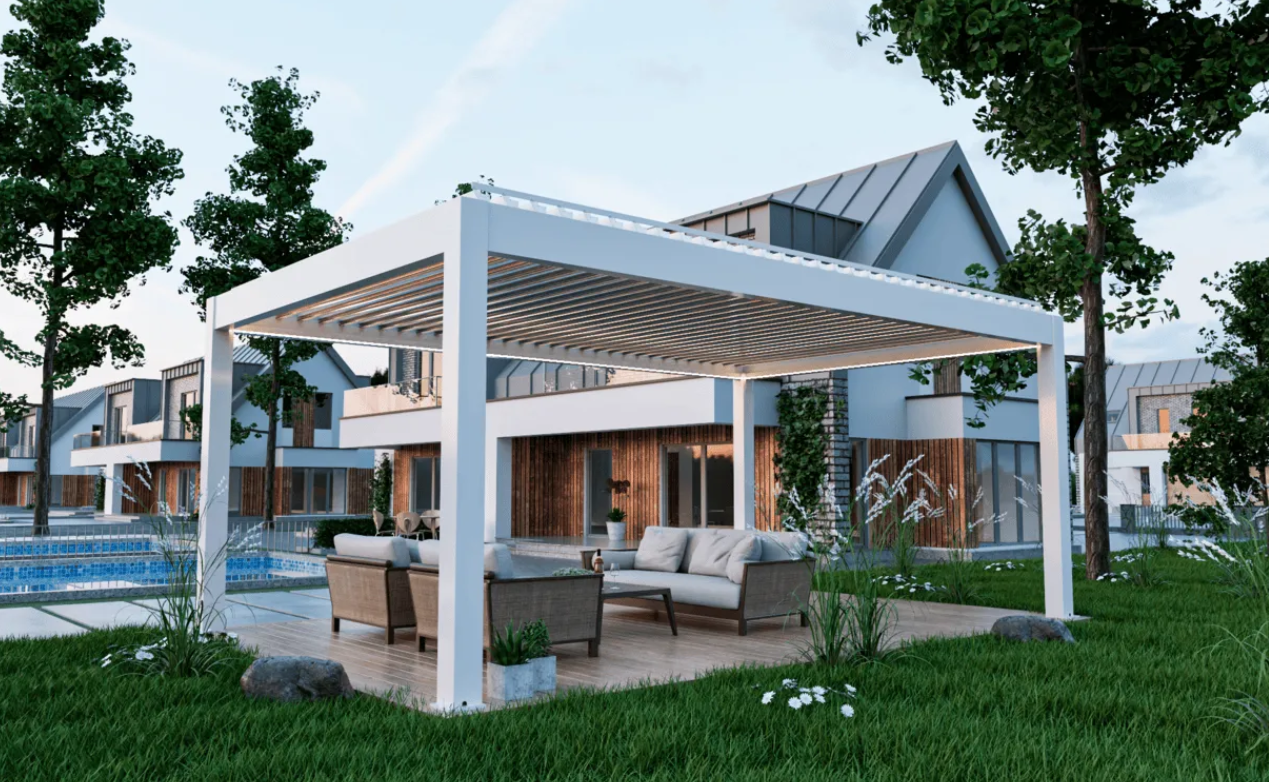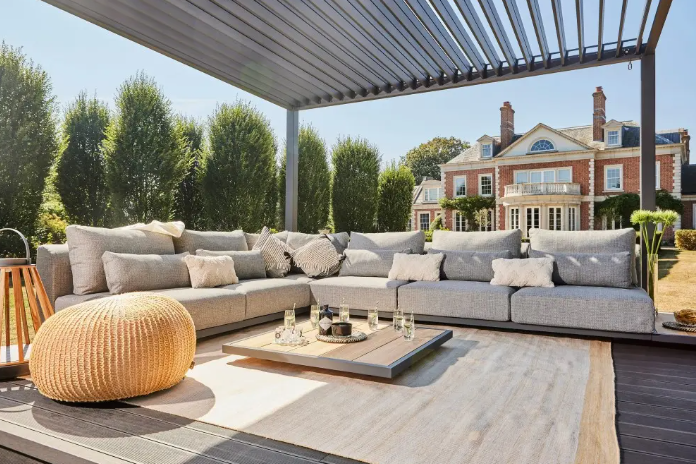Defining Your Garden's Personality with Freestanding Pergolas
Architectural Focal Point Without Structural Attachments
A freestanding pergola stands on its own ground, turning gardens into striking architectural statements without needing any attachment to buildings or walls. These independent structures bring flexibility to garden design, making outdoor spaces look better visually while still letting people personalize them according to what they like best. Homeowners have plenty of choices when it comes to materials too. Some prefer sleek aluminum frames, others go for wood that looks weathered and old fashioned, and there are even those who love simple steel constructions. Landscape pros such as Piet Oudolf and Thomas Church often include these standalone pergolas in their work, creating designs that blend naturally with surroundings yet still stand out architecturally. Their approach shows how something so basic can become part of a beautiful whole.
Customizable Footprint for Landscape Integration
Freestanding pergolas have a real advantage when it comes to fitting into different garden spaces. They offer flexible footprints that work well with whatever landscape features happen to be there. Getting good results really depends on taking accurate measurements and thinking through how everything will look together with plants, patios, and walkways around the area. Garden owners often get creative with shapes and arrangements too, from small cozy corners to large open structures that cover bigger areas. Adjusting both dimensions and positioning helps make sure the pergola feels like part of the garden itself rather than something tacked on. This integration not only looks better but also makes the outdoor space more useful for everyday enjoyment.
Visual Flow Preservation in Open-Air Designs
Freestanding pergolas help create separate areas in gardens and patios without breaking the overall look of the space. These structures allow homeowners to set aside spots for different activities like lounging, entertaining guests, or enjoying meals outside. When placed strategically along natural lines of sight across the yard, pergolas become focal points that draw attention from multiple directions and create welcoming outdoor corners. Homes with well thought out exterior spaces tend to fetch better prices on the market too. Some studies suggest properties with attractive outdoor living areas can see their value jump anywhere between 20% to 30%. Incorporating pergolas into landscape design not only makes the backyard more functional but also adds long term value to the property without looking too刻意 (deliberate).
The Airflow Advantage of Standalone Pergolas
360-Degree Ventilation for Lounging Comfort
Standalone pergolas give pretty much all around ventilation, which makes them great for boosting comfort outside. They let in natural airflow, so people can actually stay cool even when it gets warm out there. The open rafters and those adjustable panels really help with this whole thing, letting air move through while still offering some protection from sun or light rain. There was this research in the Journal of Environmental Management that looked at how smart pergola designs make lounging areas much more comfortable because of better airflow. What's nice about these features is they allow folks who love their gardens and outdoor living spaces to spend time outside no matter what kind of weather rolls in.

Microclimate Control for Sensitive Plants
Freestanding pergolas really make a difference when it comes to creating those little pockets of protection for plants that struggle with tough weather. They give partial shade and some wind protection, which helps keep things at a steadier temperature and moisture level that many delicate plants actually need to survive. Orchids and ferns especially seem to love growing under pergolas, so garden lovers who want to try these tricky but beautiful plants should definitely consider adding one. Garden experts often talk about how important controlled climates are for successful planting, and pergolas let people create just the right spot for different plants without going overboard on expensive equipment or complicated systems.
Cross-Breeze Optimization in Summer Months
Pergolas that are properly positioned and built right can really boost airflow throughout the summer season. When placed correctly to catch the wind direction, they create natural cooling that makes sitting outside much more comfortable. Where exactly something like this sits in the yard matters a lot for how well it works. Some folks report feeling noticeably cooler when their pergola is set up just right. Landscape professionals have seen this firsthand too. They've worked on projects where strategic pergola placement transformed hot spots into pleasant areas where people actually want to spend time. The right setup not only keeps things cooler but also looks great, turning an ordinary backyard into something special.
Sunlight Management Through Adjustable Design
Rotating Slat Systems for Precision Shade
Rotating slat systems give homeowners amazing control over how much sun gets into their outdoor spaces, letting them adjust shades all day long according to what works best. They cut down on harmful UV rays and stop excessive heat from building up, which makes spending time outside actually pleasant instead of uncomfortable. The adjustable slats let people tweak the position depending on where the sun is at different times of day, so there's always just the right amount of shade when needed. Joe Raboine at Belgard Outdoor Living often talks about how these systems really transform backyards, turning areas that would otherwise be too hot or bright into usable spaces where families can gather comfortably while still getting some natural light.
UV Protection Strategies for Outdoor Furnishings
Keeping outdoor furniture safe from UV damage takes some thought and good material choices. A freestanding pergola can work wonders as a shaded area where furniture stays protected from the sun's harsh effects. Most folks find that fabrics made of polyester or acrylic hold up better against weather than regular cotton does. Bryan Clayton over at GreenPal has seen this firsthand while working with clients across the country. He always stresses how important it is to block those UV rays if people want their patio sets to last longer. His go-to suggestion? Look for pergolas with adjustable beams or covers that can be pulled down when needed. This simple step makes all the difference in protecting expensive outdoor investments.
Seasonal Angle Adaptation Techniques
Changing the angle of pergolas throughout different seasons makes a big difference in how much sun gets through versus how much shade we get outside. Homeowners might want to consider getting those fancy motorized slats installed if they're looking for something that adjusts easily without too much effort. People who actually manage their pergola settings according to the weather tend to spend way more time outdoors during all sorts of conditions. The ability to tweak these structures keeps them useful no matter what time of year it is, which matters because where the sun sits changes constantly from summer to winter. Most professionals will tell anyone interested in building one that matching the pergola style to what kind of weather typically hits the area really improves how people feel when they use the space.
Installation Flexibility and Groundwork Considerations
Minimal Foundation Requirements Explained
One big plus of freestanding pergolas is how little foundation work they need when compared to regular structures, which makes them pretty efficient for creating those modern outdoor living areas people love so much these days. Homeowners have several options for getting these things installed too. Ground screws work great on many properties, there's also the option of concrete pads, and some newer techniques have come along recently as well. The point is folks can pick what works best for their particular yard situation without having to dig up the whole place. Because of this flexibility in how they sit on the ground, installation actually goes much faster than most people expect. We've seen cases where a freestanding pergola gets put together in about half the time it would take for building something more traditional from scratch.
DIY Kit Assembly Walkthroughs
When talking about freestanding pergolas, what stands out most is how straightforward they are to put together using DIY kits. Homeowners who want to spruce up their backyard don't need expert help thanks to this accessibility factor. Most kits come packed with instructions that walk people through each step, and many manufacturers now throw in online videos too. People actually report pretty good results from putting these things together themselves. Even folks who aren't exactly handy with tools find themselves managing fine, which takes away much of the usual frustration associated with home projects.
Preserving Existing Landscaping During Setup
When putting up freestanding pergolas, one thing worth remembering is how important it is to leave the surrounding landscape mostly untouched. Good planning makes all the difference here, especially if there are plants or wildlife already thriving in the area. Before digging starts, smart homeowners will sketch out where everything stands now and mark those spots so nobody accidentally disturbs them later on. Most landscape pros suggest going green whenever possible, using techniques that keep things in balance with nature itself. After all, nobody wants their garden turned into something artificial just because they added a nice looking pergola. Taking care of what's already there ends up creating better outdoor living spaces too, since everyone enjoys spending time among real plants instead of plastic ones.
Material Choices for Permanent and Portable Use
Lightweight Aluminum Framing Benefits
Lightweight aluminum makes a great material choice for freestanding pergolas because it lasts longer and needs almost no upkeep compared to other options. When it comes to standing up against harsh weather, aluminum holds its own far better than wood ever could. No warping, no rotting, definitely no need for constant painting sessions that drive everyone crazy. That kind of low maintenance really adds up financially in the long run. Companies like Gosforth Outdoor have made their mark by creating these aluminum structures, and they back them up with solid warranty coverage too. Most warranties cover things like corrosion and structural damage for years down the road, which gives homeowners something to feel good about when they're investing in outdoor living spaces.
Weather-Resistant Wood Treatment Options
Wooden freestanding pergolas need proper care to last through all seasons. Applying weather resistant stuff like sealant, stain or paint helps keep moisture out and stops sun damage from ruining the wood over time. Picking the right kind of timber matters too depending on where they'll be installed. Cedar and redwood stand out because they naturally fight off rot and bugs better than most woods. Many garden experts including landscape pro Danny Lipford stress that keeping these structures maintained makes them look good longer while avoiding costly replacements down the road. Regular checks and fresh coats of protection go a long way toward preserving both function and beauty.
Quick-Disconnect Hardware for Future Relocation
Pergolas with quick disconnect hardware make it much easier to take them apart and move them around when needed. Gardeners often find this really helpful if they need to adjust things because seasons change or their landscape gets updated over time. Being able to just pick up a pergola and put it somewhere else saves tons of headaches, giving folks way more options for how they arrange their gardens. Landscape architects such as Martha Schwartz Partners talk about how important these kinds of systems are for making outdoor areas that can actually adapt to what people want. The whole point is that pergolas stay useful even as gardens grow and change, combining solid construction with the freedom to move them whenever necessary for different purposes.
Long-Term Value and Adaptability Factors
Cost/Benefit Analysis of Permanent vs Removable Models
Before buying a pergola, it pays to think about whether a fixed model or something that can be moved around makes more sense for the budget. Fixed freestanding pergolas tend to last longer because they're built solidly from materials like pressure treated wood or metal frames. These structures require less upkeep over the years since they don't need adjusting season after season. On the flip side, portable pergolas give garden owners more freedom. They can simply lift them up and move them somewhere else when landscaping plans change, no need to tear anything down completely. Installation typically costs less too since most portable options come mostly assembled or with straightforward setup instructions. Homeowners who live in areas where weather patterns shift dramatically throughout the year often find themselves saving money in the long run by going with removable designs. One family in Colorado reported cutting their outdoor project expenses nearly in half after switching to movable pergolas whenever they wanted to refresh their backyard space.
Growth Accommodation for Climbing Flora
Pergolas work really well for growing climbing plants, adding both beauty and charm to gardens and patios. The framework supports different kinds of greenery - think wisteria, clematis or maybe even some honeysuckle. These plants tend to do great when given something solid to climb on. When they start blooming through the seasons, the whole area changes look constantly. Some folks who know their stuff recommend picking plants that match up with what kind of weather we get locally. If someone lives somewhere with milder winters, jasmine and passionflower might be good bets. But down south where it stays warm most of the time, bougainvillea becomes a real standout plant choice, putting on color and greenery practically nonstop.
Reconfiguration Potential During Yard Redesigns
Freestanding pergolas are really versatile things that work great when people want to change up their yards later on. The nice thing about them is that homeowners don't need to tear everything down just because their tastes or landscape plans shift over time. Many modern gardens keep changing look pretty regularly, so having something adaptable makes all the difference. Gardeners love how easy it is to work around these structures when updating their outdoor space. People who've installed pergolas tell stories about adding new seating spots or even putting in little kitchenettes right next to them without much hassle at all. These structures just seem to slot right into whatever new plan comes along, which explains why so many folks consider them worth the investment despite the initial cost.
FAQ Section
What are the benefits of using freestanding pergolas?
Freestanding pergolas offer flexibility in design without requiring connections to existing structures. They enhance aesthetic appeal, provide 360-degree ventilation, create microclimates for sensitive plants, and are adaptable to different garden layouts.
How do freestanding pergolas manage sunlight and UV exposure?
Freestanding pergolas manage sunlight through adjustable design features such as rotating slat systems and seasonal angle adaptation. They offer UV protection for outdoor furnishings using weather-resistant materials.
Can freestanding pergolas be installed easily?
Yes, freestanding pergolas have minimal foundation requirements, often allowing for faster and more cost-effective installation using methods like ground screws or concrete pads. DIY kits are available for simpler assembly.
Are freestanding pergolas suitable for the growth of climbing plants?
Indeed, freestanding pergolas support climbing plants such as wisteria, clematis, and honeysuckle, enhancing the natural beauty of outdoor spaces. They provide sturdy frameworks for optimal plant growth.
What materials are recommended for building freestanding pergolas?
Lightweight aluminum and treated wood are popular materials for pergolas. Aluminum is durable and weather-resistant, while treated wood offers natural resistance to decay and pests.Â
Table of Contents
-
Defining Your Garden's Personality with Freestanding Pergolas
- Architectural Focal Point Without Structural Attachments
- Customizable Footprint for Landscape Integration
- Visual Flow Preservation in Open-Air Designs
- The Airflow Advantage of Standalone Pergolas
- 360-Degree Ventilation for Lounging Comfort
- Microclimate Control for Sensitive Plants
- Cross-Breeze Optimization in Summer Months
- Sunlight Management Through Adjustable Design
- Rotating Slat Systems for Precision Shade
- UV Protection Strategies for Outdoor Furnishings
- Seasonal Angle Adaptation Techniques
- Installation Flexibility and Groundwork Considerations
- Minimal Foundation Requirements Explained
- DIY Kit Assembly Walkthroughs
- Preserving Existing Landscaping During Setup
- Material Choices for Permanent and Portable Use
- Lightweight Aluminum Framing Benefits
- Weather-Resistant Wood Treatment Options
- Quick-Disconnect Hardware for Future Relocation
- Long-Term Value and Adaptability Factors
- Cost/Benefit Analysis of Permanent vs Removable Models
- Growth Accommodation for Climbing Flora
- Reconfiguration Potential During Yard Redesigns
- FAQ Section



